
Illustrative Math Alignment: Grade 6 Unit 1
Dividing Fractions
Lesson 16: Solving Problems Involving Fractions
Use the following Media4Math resources with this Illustrative Math lesson.
| Thumbnail Image | Title | Body | Curriculum Nodes |
|---|---|---|---|
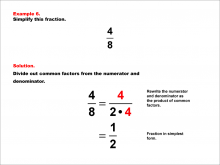
|
Math Example--Fraction Properties--Simplifying Fractions--Example 6 | Simplifying Fractions--Example 6TopicFractions DescriptionThis example presents the fraction 4/8 and guides students to recognize that the GCD is 4. Simplifying to 1/2, this problem emphasizes the significance of understanding common factors in fractions, an essential skill in mathematics. For a complete collection of math examples related to Simplifying Fractions click on this link: Math Examples: Simplifying Fractions Collection. |
Write Fractions in Lowest Terms |
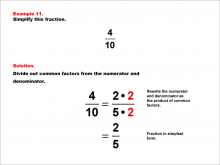
|
Math Example--Fraction Properties--Simplifying Fractions--Example 11 | Simplifying Fractions--Example 11TopicFractions DescriptionThis example demonstrates simplifying the fraction 4/10 by finding the greatest common divisor (GCD), which is 2. The simplified form is 2/5. This teaches students about recognizing common factors and reducing fractions to their simplest form. For a complete collection of math examples related to Simplifying Fractions click on this link: Math Examples: Simplifying Fractions Collection. |
Write Fractions in Lowest Terms |
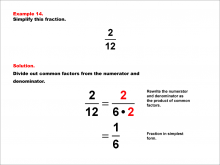
|
Math Example--Fraction Properties--Simplifying Fractions--Example 14 | Simplifying Fractions--Example 14TopicFractions DescriptionThis example demonstrates simplifying the fraction 2/12 by finding the GCD, which is 2. The simplified form is 1/6. This teaches students about recognizing common factors and reducing fractions to their simplest form. For a complete collection of math examples related to Simplifying Fractions click on this link: Math Examples: Simplifying Fractions Collection. |
Write Fractions in Lowest Terms |

|
Math Example--Fraction Properties--Simplifying Fractions--Example 18 | Math Example--Fraction Properties--Simplifying Fractions--Example 18TopicFractions DescriptionThis example demonstrates simplifying the fraction 8/12 by finding the GCD, which is 4. The simplified form is 2/3. This teaches students about recognizing common factors and reducing fractions to their simplest form. For a complete collection of math examples related to Simplifying Fractions click on this link: Math Examples: Simplifying Fractions Collection. |
Write Fractions in Lowest Terms |
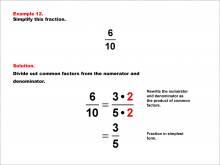
|
Math Example--Fraction Properties--Simplifying Fractions--Example 12 | Math Example--Fraction Properties--Simplifying Fractions--Example 12TopicFractions DescriptionThis example demonstrates simplifying the fraction 6/10 by finding the GCD, which is 2. The simplified form is 3/5. This teaches students about recognizing common factors and reducing fractions to their simplest form. For a complete collection of math examples related to Simplifying Fractions click on this link: Math Examples: Simplifying Fractions Collection. |
Write Fractions in Lowest Terms |
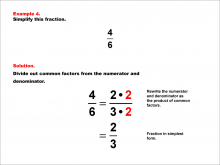
|
Math Example--Fraction Properties--Simplifying Fractions--Example 4 | Simplifying Fractions--Example 4TopicFractions DescriptionThis example illustrates the simplification of 4/6. Students learn to identify the GCD, which is 2, allowing them to reduce the fraction to 2/3. This practice strengthens their skills in division and enhances their understanding of number relationships, vital for more complex fraction concepts. For a complete collection of math examples related to Simplifying Fractions click on this link: Math Examples: Simplifying Fractions Collection. |
Write Fractions in Lowest Terms |
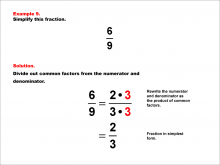
|
Math Example--Fraction Properties--Simplifying Fractions--Example 9 | Simplifying Fractions--Example 9TopicFractions DescriptionThis example demonstrates the simplification of the fraction 6/9. Students identify the GCD as 3, simplifying the fraction to 2/3. This exercise enhances their understanding of division and equivalent fractions, essential for advanced mathematical concepts. For a complete collection of math examples related to Simplifying Fractions click on this link: Math Examples: Simplifying Fractions Collection. |
Write Fractions in Lowest Terms |
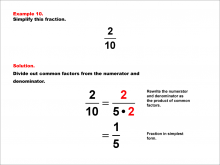
|
Math Example--Fraction Properties--Simplifying Fractions--Example 10 | Simplifying Fractions--Example 10TopicFractions DescriptionThis example focuses on simplifying the fraction 2/10. By finding the GCD, which is 2, students simplify the fraction to 1/5. This activity reinforces their skills in recognizing common factors and understanding equivalent fractions. For a complete collection of math examples related to Simplifying Fractions click on this link: Math Examples: Simplifying Fractions Collection. |
Write Fractions in Lowest Terms |
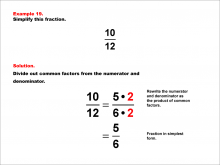
|
Math Example--Fraction Properties--Simplifying Fractions--Example 19 | Simplifying Fractions--Example 19TopicFractions DescriptionThis example demonstrates simplifying the fraction 10/12 by finding the GCD, which is 2. The simplified form is 5/6. This teaches students about recognizing common factors and reducing fractions to their simplest form. For a complete collection of math examples related to Simplifying Fractions click on this link: Math Examples: Simplifying Fractions Collection. |
Write Fractions in Lowest Terms |

|
Math Example--Fraction Properties--Simplifying Fractions--Example 5 | Simplifying Fractions--Example 5TopicFractions DescriptionFocusing on the fraction 2/8, this example highlights the process of finding the GCD, which is 2. Through division, students simplify the fraction to 1/4. This exercise reinforces their skills in problem-solving and critical thinking regarding fractions. For a complete collection of math examples related to Simplifying Fractions click on this link: Math Examples: Simplifying Fractions Collection. |
Write Fractions in Lowest Terms |
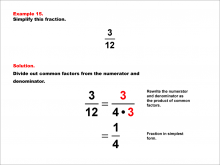
|
Math Example--Fraction Properties--Simplifying Fractions--Example 15 | Simplifying Fractions--Example 15TopicFractions DescriptionThis example demonstrates simplifying the fraction 3/12 by finding the GCD, which is 3. The simplified form is 1/4. This teaches students about recognizing common factors and reducing fractions to their simplest form. For a complete collection of math examples related to Simplifying Fractions click on this link: Math Examples: Simplifying Fractions Collection. |
Write Fractions in Lowest Terms |

|
Math Example--Fraction Properties--Simplifying Fractions--Example 13 | Simplifying Fractions--Example 13TopicFractions DescriptionThis example demonstrates simplifying the fraction 8/10 by finding the GCD, which is 2. The simplified form is 4/5. This teaches students about recognizing common factors and reducing fractions to their simplest form. For a complete collection of math examples related to Simplifying Fractions click on this link: Math Examples: Simplifying Fractions Collection. |
Write Fractions in Lowest Terms |
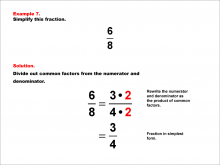
|
Math Example--Fraction Properties--Simplifying Fractions--Example 7 | Simplifying Fractions--Example 7TopicFractions DescriptionIn this case, the fraction 6/8 is shown, where the GCD is identified as 2. Simplifying the fraction leads to 3/4, a practical example that helps students master the concept of equivalent fractions and the importance of factoring in mathematics. For a complete collection of math examples related to Simplifying Fractions click on this link: Math Examples: Simplifying Fractions Collection. |
Write Fractions in Lowest Terms |
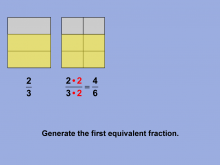
|
Math Clip Art--Fraction Concepts--Equivalent Fractions 12 | Math Clip Art--Fraction Concepts--Equivalent Fractions 12TopicFractions DescriptionThis image shows the next fraction in the sequence: 4/6. It displays a rectangular model divided into six parts with four parts shaded, representing 4/6. It may also include the numerical process of multiplying both the numerator and denominator of 2/3 by 2 to get 4/6. This representation helps students understand how to create equivalent fractions by multiplying both the numerator and denominator by the same number. It provides both a visual and potentially numerical explanation of the process. |
Find Equivalent Fractions and Identify and Name Fractions |
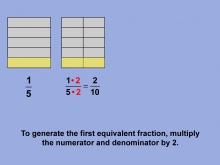
|
Math Clip Art--Fraction Concepts--Equivalent Fractions 07 | Math Clip Art--Fraction Concepts--Equivalent Fractions 07TopicFractions DescriptionThis image builds on the previous one, showing 2/10 with a rectangular model and demonstrating how to generate this equivalent fraction numerically. It displays a rectangle divided into ten parts with two parts shaded, alongside the numerical process of multiplying both the numerator and denominator of 1/5 by 2 to get 2/10. This representation helps students understand how to create equivalent fractions by multiplying both the numerator and denominator by the same number. It provides both a visual and numerical explanation of the process. |
Find Equivalent Fractions and Identify and Name Fractions |
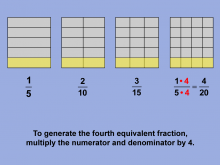
|
Math Clip Art--Fraction Concepts--Equivalent Fractions 09 | Math Clip Art--Fraction Concepts--Equivalent Fractions 09TopicFractions DescriptionThis image completes the short sequence by showing 4/20 with a rectangular model and the numerical process to generate this equivalent fraction. It displays a rectangle divided into 20 parts with four parts shaded, alongside the numerical process of multiplying both the numerator and denominator of 1/5 by 4 to get 4/20. This representation completes the pattern of equivalent fractions for 1/5 and reinforces the concept of generating equivalent fractions by multiplying both the numerator and denominator by the same number. |
Find Equivalent Fractions and Identify and Name Fractions |
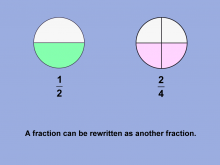
|
Math Clip Art--Fraction Concepts--Equivalent Fractions 02 | Math Clip Art--Fraction Concepts--Equivalent Fractions 02TopicFractions DescriptionThis image presents circular fraction models for 1/2 and 2/4, illustrating that equal fractions can be written in different forms. It shows two circles side by side, one divided into two equal parts with one part shaded (representing 1/2), and the other divided into four equal parts with two parts shaded (representing 2/4). This visual representation helps students understand that fractions can look different but represent the same amount. It introduces the fundamental concept of equivalent fractions using a familiar circular model. |
Find Equivalent Fractions and Identify and Name Fractions |
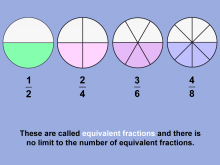
|
Math Clip Art--Fraction Concepts--Equivalent Fractions 03 | Math Clip Art--Fraction Concepts--Equivalent Fractions 03TopicFractions DescriptionThis image displays circular fraction models that are equivalent: 1/2, 2/4, 3/6, and 4/8. It shows four circles side by side, each divided and shaded to represent these fractions. This visual representation expands on the previous image, showing multiple equivalent fractions. It helps students see the pattern in equivalent fractions and understand that as both the numerator and denominator are multiplied by the same number, the fraction's value remains the same. Teachers can use this image to discuss patterns in equivalent fractions and to introduce the concept of simplifying and expanding fractions. |
Find Equivalent Fractions and Identify and Name Fractions |
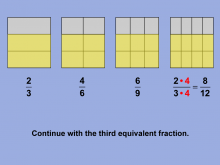
|
Math Clip Art--Fraction Concepts--Equivalent Fractions 14 | Math Clip Art--Fraction Concepts--Equivalent Fractions 14TopicFractions DescriptionThis image shows the final fraction in the sequence: 8/12. It displays a rectangular model divided into twelve parts with eight parts shaded, representing 8/12. It may also include the numerical process of multiplying both the numerator and denominator of 2/3 by 4 to get 8/12. |
Find Equivalent Fractions and Identify and Name Fractions |

|
Math Clip Art--Fraction Concepts--Equivalent Fractions 08 | Math Clip Art--Fraction Concepts--Equivalent Fractions 08TopicFractions DescriptionThis image continues the sequence, now showing 3/15 with a rectangular model and the numerical process to generate this equivalent fraction. It displays a rectangle divided into 15 parts with three parts shaded, alongside the numerical process of multiplying both the numerator and denominator of 1/5 by 3 to get 3/15. This representation further reinforces the concept of generating equivalent fractions and helps students see the pattern emerging in the sequence. |
Find Equivalent Fractions and Identify and Name Fractions |
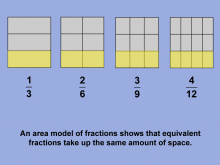
|
Math Clip Art--Fraction Concepts--Equivalent Fractions 04 | Math Clip Art--Fraction Concepts--Equivalent Fractions 04TopicFractions DescriptionThis image presents a variation with rectangular models showing equivalent fractions: 1/3, 2/6, 3/9, and 4/12. It displays four rectangles side by side, each divided and shaded to represent these fractions. This representation introduces a new model for understanding equivalent fractions. It helps students see that the concept of equivalent fractions applies across different visual representations and reinforces the pattern of multiplying both numerator and denominator by the same number. |
Find Equivalent Fractions and Identify and Name Fractions |
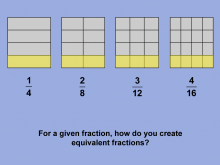
|
Math Clip Art--Fraction Concepts--Equivalent Fractions 05 | Math Clip Art--Fraction Concepts--Equivalent Fractions 05TopicFractions DescriptionThis image shows another variation with rectangular models demonstrating equivalent fractions: 1/4, 2/8, 3/12, and 4/16. It displays four rectangles side by side, each divided and shaded to represent these fractions. This representation further reinforces the concept of equivalent fractions using a different set of fractions. It helps students see the pattern in creating equivalent fractions by multiplying both the numerator and denominator by the same number. |
Find Equivalent Fractions and Identify and Name Fractions |
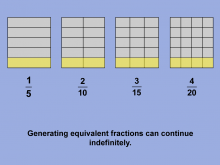
|
Math Clip Art--Fraction Concepts--Equivalent Fractions 10 | Math Clip Art--Fraction Concepts--Equivalent Fractions 10TopicFractions DescriptionThis image serves as a summary slide showing the four equivalent fractions explored in the previous sequence: 1/5, 2/10, 3/15, and 4/20. It displays all four rectangular models side by side, clearly demonstrating their equivalence and reinforcing that this process can continue indefinitely. This representation provides a comprehensive view of the equivalent fractions, allowing students to see the progression and pattern all at once. It reinforces the concept that these fractions, despite looking different, all represent the same amount. |
Find Equivalent Fractions and Identify and Name Fractions |
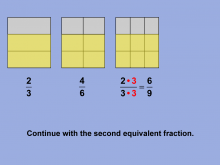
|
Math Clip Art--Fraction Concepts--Equivalent Fractions 13 | Math Clip Art--Fraction Concepts--Equivalent Fractions 13TopicFractions DescriptionThis image continues the sequence, now showing 6/9. It displays a rectangular model divided into nine parts with six parts shaded, representing 6/9. It may also include the numerical process of multiplying both the numerator and denominator of 2/3 by 3 to get 6/9. This representation further reinforces the concept of generating equivalent fractions and helps students see the pattern emerging in the sequence. Teachers can use this image to continue the discussion on equivalent fractions and to encourage students to predict the next fraction in the sequence. |
Find Equivalent Fractions and Identify and Name Fractions |
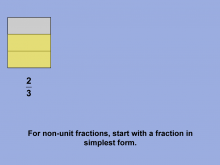
|
Math Clip Art--Fraction Concepts--Equivalent Fractions 11 | Math Clip Art--Fraction Concepts--Equivalent Fractions 11TopicFractions DescriptionThis image starts a new sequence focusing on equivalent fractions of 2/3. It shows a rectangular fraction model divided into three equal parts with two parts shaded, representing 2/3. This representation introduces students to a new fraction and sets the stage for exploring its equivalent forms. It provides a clear visual model for students to understand what 2/3 looks like. Teachers can use this image to begin a discussion about fractions with a numerator greater than 1 and to prepare students for generating equivalent fractions of 2/3. |
Find Equivalent Fractions and Identify and Name Fractions |

|
Math Clip Art--Fraction Concepts--Equivalent Fractions 01 | Math Clip Art--Fraction Concepts--Equivalent Fractions 01TopicFractions DescriptionThis image serves as the title card for a series on equivalent fractions. It displays the text "Equivalent Fractions" in a clear, prominent font. The background may include subtle mathematical elements or fraction-related graphics to set the context for the following images in the series. This introductory image sets the stage for the subsequent images, preparing students for an exploration of fractions that have the same value but are written differently. It provides a clear, concise title that immediately informs viewers about the specific fraction concepts they'll be studying. |
Find Equivalent Fractions and Identify and Name Fractions |
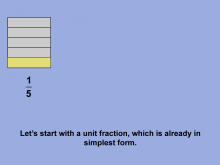
|
Math Clip Art--Fraction Concepts--Equivalent Fractions 06 | Math Clip Art--Fraction Concepts--Equivalent Fractions 06TopicFractions DescriptionThis image starts a short sequence focusing on equivalent fractions of 1/5. It shows a rectangular model divided into five equal parts with one part shaded, representing 1/5. This representation introduces students to the concept of fifths and sets the stage for exploring equivalent fractions with a denominator of 5. It provides a clear visual model for students to understand what 1/5 looks like. Teachers can use this image to begin a discussion about fractions with a denominator of 5 and to prepare students for generating equivalent fractions. |
Find Equivalent Fractions and Identify and Name Fractions |

|
Math Clip Art--Fraction Concepts--Equivalent Fractions 14 | Math Clip Art--Fraction Concepts--Equivalent Fractions 14TopicFractions DescriptionThis image shows the final fraction in the sequence: 8/12. It displays a rectangular model divided into twelve parts with eight parts shaded, representing 8/12. It may also include the numerical process of multiplying both the numerator and denominator of 2/3 by 4 to get 8/12. |
Find Equivalent Fractions and Identify and Name Fractions |
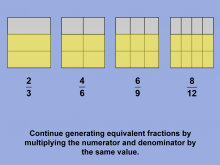
|
Math Clip Art--Fraction Concepts--Equivalent Fractions 15 | Math Clip Art--Fraction Concepts--Equivalent Fractions 15TopicFractions DescriptionThis image serves as a summary slide showing the four equivalent fractions explored in the previous sequence: 2/3, 4/6, 6/9, and 8/12. It displays all four rectangular models side by side, clearly demonstrating their equivalence. |
Find Equivalent Fractions and Identify and Name Fractions |

|
Math Clip Art--Fraction Concepts--Equivalent Fractions 15 | Math Clip Art--Fraction Concepts--Equivalent Fractions 15TopicFractions DescriptionThis image serves as a summary slide showing the four equivalent fractions explored in the previous sequence: 2/3, 4/6, 6/9, and 8/12. It displays all four rectangular models side by side, clearly demonstrating their equivalence. |
Find Equivalent Fractions and Identify and Name Fractions |
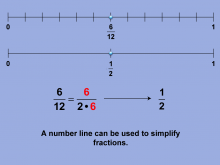
|
Math Clip Art--Fraction Concepts--Fractions in Simplest Form 07 | Math Clip Art--Fraction Concepts--Fractions in Simplest Form 07TopicFractions DescriptionThis image shows fraction number lines demonstrating the equivalence of 6/12 and 1/2. It displays two number lines, one marked from 0 to 1 with 12 equal divisions and a point at 6/12, and another marked from 0 to 1 with 2 equal divisions and a point at 1/2. This representation introduces a new model for understanding equivalent fractions and fraction simplification. It helps students visualize fractions on a linear scale and reinforces the concept that equivalent fractions occupy the same point on a number line. |
Identify and Name Fractions |
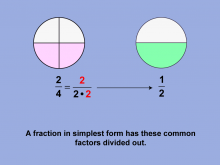
|
Math Clip Art--Fraction Concepts--Fractions in Simplest Form 04 | Math Clip Art--Fraction Concepts--Fractions in Simplest Form 04TopicFractions DescriptionThis image continues from the previous one, showing how common factors divide out when simplifying fractions. It likely displays the process of simplifying 2/4 to 1/2 with a focus on the common factor of 2, possibly using visual elements like circles or arrows to show how the common factor is removed from both the numerator and denominator. This representation helps students understand the mathematical principle behind simplifying fractions. It visually demonstrates that we're dividing both the numerator and denominator by the same number, which doesn't change the fraction's value. |
Identify and Name Fractions |
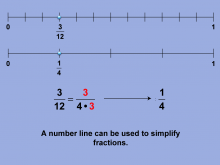
|
Math Clip Art--Fraction Concepts--Fractions in Simplest Form 08 | Math Clip Art--Fraction Concepts--Fractions in Simplest Form 08TopicFractions DescriptionThis image is a variation of the previous one, now showing the equivalence of 3/12 and 1/4 on number lines. It displays two number lines, one marked from 0 to 1 with 12 equal divisions and a point at 3/12, and another marked from 0 to 1 with 4 equal divisions and a point at 1/4. This representation further reinforces the concept of equivalent fractions using number lines. It helps students visualize how fractions with different denominators can represent the same value. |
Identify and Name Fractions |
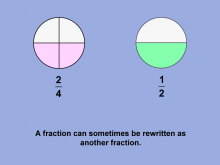
|
Math Clip Art--Fraction Concepts--Fractions in Simplest Form 02 | Math Clip Art--Fraction Concepts--Fractions in Simplest Form 02TopicFractions DescriptionThis image shows equivalent circular fraction models for 2/4 and 1/2. It displays two circles side by side, one divided into four equal parts with two parts shaded (representing 2/4), and the other divided into two equal parts with one part shaded (representing 1/2). This visual representation helps students understand that fractions can be equivalent even when written differently. It introduces the concept of simplifying fractions by showing that 2/4 and 1/2 represent the same portion of a whole. |
Identify and Name Fractions |

|
Math Clip Art--Fraction Concepts--Fractions in Simplest Form 05 | Math Clip Art--Fraction Concepts--Fractions in Simplest Form 05TopicFractions DescriptionThis image is a variation showing the equivalence of 6/8 and 3/4. It displays two circular fraction models side by side, one divided into eight parts with six shaded (representing 6/8), and the other divided into four parts with three shaded (representing 3/4). This visual representation helps students see that 6/8 and 3/4 represent the same portion of a whole, reinforcing the concept of equivalent fractions. It also provides another example of simplifying fractions, this time with a different common factor. |
Identify and Name Fractions |
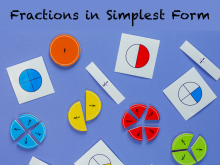
|
Math Clip Art--Fraction Concepts--Fractions in Simplest Form 01 | Math Clip Art--Fraction Concepts--Fractions in Simplest Form 01TopicFractions DescriptionThis image serves as the title card for a series on fractions in simplest form. It likely displays the text "Fractions in Simplest Form" in a clear, prominent font. The background may include subtle mathematical elements or fraction-related graphics to set the context for the following images in the series. This introductory image sets the stage for the subsequent images, preparing students for an exploration of equivalent fractions and the process of simplifying fractions. It provides a clear, concise title that immediately informs viewers about the specific fraction concepts they'll be studying. |
Identify and Name Fractions |
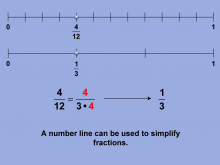
|
Math Clip Art--Fraction Concepts--Fractions in Simplest Form 09 | Math Clip Art--Fraction Concepts--Fractions in Simplest Form 09TopicFractions DescriptionThis image is another variation, now demonstrating the equivalence of 4/12 and 1/3 on number lines. It shows two number lines, one marked from 0 to 1 with 12 equal divisions and a point at 4/12, and another marked from 0 to 1 with 3 equal divisions and a point at 1/3. This representation continues to build on the concept of equivalent fractions using number lines. It helps students visualize how fractions with different denominators can represent the same value, even when the relationship isn't as immediately obvious as in previous examples. |
Identify and Name Fractions |
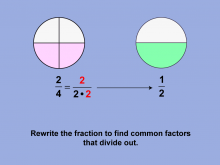
|
Math Clip Art--Fraction Concepts--Fractions in Simplest Form 03 | Math Clip Art--Fraction Concepts--Fractions in Simplest Form 03TopicFractions DescriptionThis image is a variation of the previous one, showing how to simplify 2/4. It displays the process of simplifying 2/4 to 1/2, using notation to show the division of both the numerator and denominator by their greatest common factor (2 in this case). This representation helps students understand the process of simplifying fractions. It visually demonstrates that simplifying a fraction doesn't change its value, but expresses it in its lowest terms. Teachers can use this image to explain the process of simplifying fractions and to reinforce the concept of equivalent fractions. |
Identify and Name Fractions |
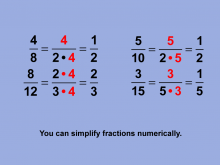
|
Math Clip Art--Fraction Concepts--Fractions in Simplest Form 10 | Math Clip Art--Fraction Concepts--Fractions in Simplest Form 10TopicFractions DescriptionThis final image in the series shows how to reduce fractions numerically, demonstrating the simplification of 4/8, 8/12, 5/10, and 3/15. It displays these fractions and their simplified forms, with visual cues to show the simplification process. This representation shifts from visual models to a more abstract, numerical approach to simplifying fractions. It helps students apply the concepts they've learned to a variety of fractions, reinforcing the process of finding common factors and dividing both the numerator and denominator. |
Identify and Name Fractions |
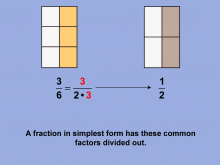
|
Math Clip Art--Fraction Concepts--Fractions in Simplest Form 06 | Math Clip Art--Fraction Concepts--Fractions in Simplest Form 06TopicFractions DescriptionThis image presents rectangular fraction models showing the equivalence of 3/6 and 1/2. It displays two rectangles side by side, one divided into six equal parts with three parts shaded (representing 3/6), and the other divided into two equal parts with one part shaded (representing 1/2). This visual representation helps students understand equivalent fractions using a different model than the circular ones previously shown. It reinforces the concept that fractions can be simplified while maintaining their value. |
Identify and Name Fractions |
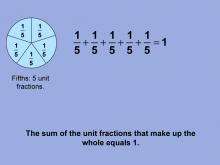
|
Math Clip Art--Fraction Concepts--Unit Fractions 09 | Math Clip Art--Fraction Concepts--Unit Fractions 09TopicFractions DescriptionThis image is a variation of the previous ones in the series, now using fifths. It shows a circle divided into five equal parts, each labeled 1/5, with an equation showing 1/5 + 1/5 + 1/5 + 1/5 + 1/5 = 1. This representation continues the pattern established in the previous images, further reinforcing the concept that unit fractions add up to a whole, regardless of the denominator. It helps students solidify their understanding of the relationship between unit fractions and the whole. |
Identify and Name Fractions |
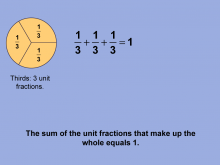
|
Math Clip Art--Fraction Concepts--Unit Fractions 07 | Math Clip Art--Fraction Concepts--Unit Fractions 07TopicFractions DescriptionThis image is a variation of the previous one, but now using thirds. It shows a circle divided into three equal parts, each labeled 1/3, with an equation showing 1/3 + 1/3 + 1/3 = 1. This representation builds on the previous example, helping students understand that the principle of unit fractions adding to a whole applies to different denominators. It reinforces the concept of fraction addition and the relationship between unit fractions and the whole. Teachers can use this image to extend students' understanding of adding unit fractions and to discuss patterns they might notice as the denominator changes. |
Identify and Name Fractions |

|
Math Clip Art--Fraction Concepts--Unit Fractions 06 | Math Clip Art--Fraction Concepts--Unit Fractions 06TopicFractions DescriptionThis image demonstrates that the sum of unit fractions from a circular fraction is 1, using halves as an example. It shows a circle divided into two equal parts, each labeled 1/2, with an equation showing 1/2 + 1/2 = 1. This visual representation helps students understand that unit fractions can be added together to form a whole. It reinforces the concept of fraction addition and the relationship between unit fractions and the whole. Teachers can use this image to introduce or reinforce the concept of adding fractions, particularly unit fractions, and to discuss the meaning of a "whole" in fraction terms. |
Identify and Name Fractions |
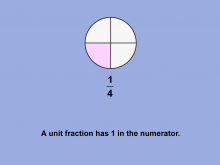
|
Math Clip Art--Fraction Concepts--Unit Fractions 02 | Math Clip Art--Fraction Concepts--Unit Fractions 02TopicFractions DescriptionThis image illustrates the unit fraction 1/4 both as a numerical fraction and as a circular fraction model. It shows the fraction 1/4 written out, alongside a circle divided into four equal parts with one part shaded or highlighted. This representation helps students connect the abstract numerical concept of a unit fraction with a concrete visual model. It reinforces the understanding that a unit fraction has a numerator of 1 and represents one equal part of a whole divided into some number of equal parts. |
Identify and Name Fractions |

|
Math Clip Art--Fraction Concepts--Unit Fractions 03 | Math Clip Art--Fraction Concepts--Unit Fractions 03TopicFractions DescriptionThis image demonstrates that a circular fraction for fourths is made up of four 1/4 sections. It shows a circle divided into four equal parts, with each part labeled as 1/4. This visual representation helps students understand that four unit fractions of 1/4 make up a whole. This illustration is crucial for helping students grasp the concept of unit fractions and how they relate to the whole. It visually demonstrates that unit fractions are equal parts of a whole and that combining all the unit fractions results in the whole. |
Identify and Name Fractions |
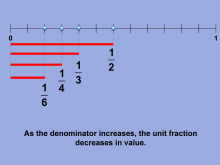
|
Math Clip Art--Fraction Concepts--Unit Fractions 10 | Math Clip Art--Fraction Concepts--Unit Fractions 10TopicFractions DescriptionThis image provides a visual comparison of unit fractions 1/2, 1/3, 1/4, and 1/6, demonstrating that as the denominator increases, the value of the unit fraction decreases. It shows different unit fractions on a number line with a visual comparison of their lengths. This representation helps students visualize the relative sizes of different unit fractions. It clearly illustrates that while each fraction represents one part, the size of that part decreases as the whole is divided into more pieces. |
Identify and Name Fractions |

|
Math Clip Art--Fraction Concepts--Unit Fractions 07 | Math Clip Art--Fraction Concepts--Unit Fractions 07TopicFractions DescriptionThis image is a variation of the previous one, but now using thirds. It shows a circle divided into three equal parts, each labeled 1/3, with an equation showing 1/3 + 1/3 + 1/3 = 1. This representation builds on the previous example, helping students understand that the principle of unit fractions adding to a whole applies to different denominators. It reinforces the concept of fraction addition and the relationship between unit fractions and the whole. Teachers can use this image to extend students' understanding of adding unit fractions and to discuss patterns they might notice as the denominator changes. |
Identify and Name Fractions |

|
Math Clip Art--Fraction Concepts--Unit Fractions 10 | Math Clip Art--Fraction Concepts--Unit Fractions 10TopicFractions DescriptionThis image provides a visual comparison of unit fractions 1/2, 1/3, 1/4, and 1/6, demonstrating that as the denominator increases, the value of the unit fraction decreases. It shows different unit fractions on a number line with a visual comparison of their lengths. This representation helps students visualize the relative sizes of different unit fractions. It clearly illustrates that while each fraction represents one part, the size of that part decreases as the whole is divided into more pieces. |
Identify and Name Fractions |
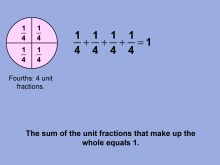
|
Math Clip Art--Fraction Concepts--Unit Fractions 08 | Math Clip Art--Fraction Concepts--Unit Fractions 08TopicFractions DescriptionThis image is another variation, now using fourths. It shows a circle divided into four equal parts, each labeled 1/4, with an equation showing 1/4 + 1/4 + 1/4 + 1/4 = 1. This representation continues to build on the previous examples, further reinforcing the concept that unit fractions add up to a whole, regardless of the denominator. It helps students see the pattern forming as the number of unit fractions increases. Teachers can use this image to further extend students' understanding of adding unit fractions and to encourage them to predict what might happen with other denominators. |
Identify and Name Fractions |

|
Math Clip Art--Fraction Concepts--Unit Fractions 08 | Math Clip Art--Fraction Concepts--Unit Fractions 08TopicFractions DescriptionThis image is another variation, now using fourths. It shows a circle divided into four equal parts, each labeled 1/4, with an equation showing 1/4 + 1/4 + 1/4 + 1/4 = 1. This representation continues to build on the previous examples, further reinforcing the concept that unit fractions add up to a whole, regardless of the denominator. It helps students see the pattern forming as the number of unit fractions increases. Teachers can use this image to further extend students' understanding of adding unit fractions and to encourage them to predict what might happen with other denominators. |
Identify and Name Fractions |